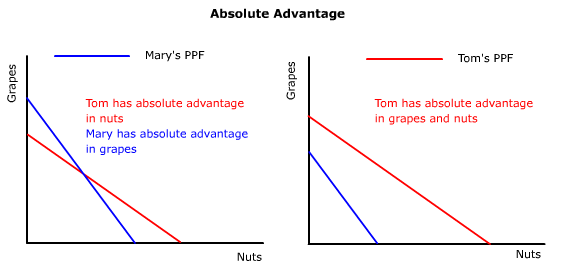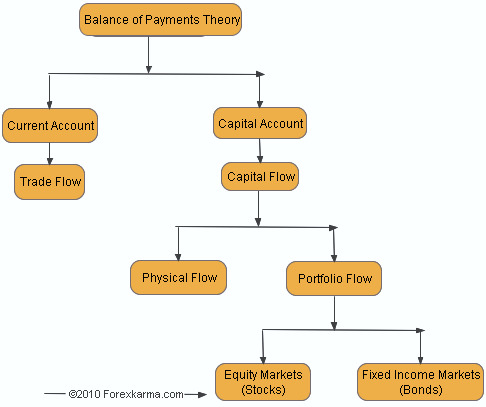Absolute Advantage
- Individual - Exists when a person can produce more of a certain good/service than someone else in the same amount of time
- National - same as individual
- Looking at what's faster, more efficient
Comparative Advantage
- Individual/National - When they can produce good/service at a lower opportunity cost than another individual or nation
- Only one nation can have the absolute advantage in one product
- Looking at lower opportunity cost
Input Problem vs. Output Problem (Comparative)
- Input Problem - What can be produced using least amount of resources (land or time)
- Output Problem - Deals with production
- What is given up/what is produced
- Both problems look at lower opportunity cost

Appreciation
- Each dollar gets you more of the other currency
- More of the foreign currency is needed to buy each dollar
- US exports get more expensive for foreigners
- US imports get cheaper for us
- Exports decrease, imports increase, GDP decrease
- Demand for the U.S. dollar will increase
- Supply for the U.S. dollar decrease
Depreciation
- Each dollar gets you less of the other currency
- Exports increase, imports decrease, GDP increase
- US exports get cheaper for foreigners to buy
- US imports get more expensive for US
- Demand of US dollar decrease
- Supply of US dollar increase
- Sources of Supply and Demand
- Supply of US dollar comes from:
- US citizens
- Banks
- Industries wanting to make foreign purchases
- Investments
- Assets
- By making transfer payments to foreigners
- Demand of the U.S. dollar comes from:
- Foreigners
- Banks
- Industries wanting to purchase our goods
- Investments
- Assets
- Make transfer payments to us
Foreign Exchange (FOREX) - The buying/selling of currency
- Ex. In order to purchase souvenirs in France, it is first necessary for Americans to sell (supply) their dollars and buy (demand) Euros
- The exchange rate (e) is determined in the foreign currency markets
- Ex. The current exchange rate is approximately 77 Japanese Yen to 1 US dollar.
- Exchange rate is price of a currency
4 Important Tips
- Always change the D line on one currency graph, the S line on the other currency's graph
- Move the lines of the two currency graphs in the same direction (right or left) and you have correct answer)
- If D on one graph increases, S on the other will also increase
- If D moves left, S moves left on other graph
Changes in Exchange Rates
- Exchange rates (e) are a function of the supply and demand for currency
- An increase in supply of currency makes it cheaper to buy one unit of it, vice versa for a decrease in supply
- An increase in demand of currency will make buying one unit more expensive, vice versa for decrease in demand
- Appreciation - Occurs when the exchange rate of that currency increases (e increases)
- Depreciation - Occurs when exchange rate of that currency decreases (e decreases)
Determinants of Exchange Rate
- Consumer Tastes
- Ex. A preference for Japanese goods creates an increase in demand of Yen and an increase in the supply of the dollar
- Relative Economy
- Imports tend to be normal goods
- Ex. if Mexico's economy is becoming stronger and the U.S. Economy is in recession, Mexicans will buy more of everything including American goods
- Increases demand for dollar, causing dollar to appreciate and the peso to depreciate
- Relative Price Level
- If PL is higher in Canada than in US, American "g"
- Speculation
- Other currency will appreciate as demand for it increases
- Supply of dollar will increase causing it to depreciate
The Balance of Payments - Measure of money inflows and outflows between the U.S. and the rest of the world (ROW)
- Inflow = Credit
- Outflow = Debit

- Balance of payments is divided into 3 accounts
- Current account
- Capital/financial account
- Official reserves account
Double Entry Bookkeeping
- Every transaction in the balance of payments is recorded twice in accordance with standard accounting practice
- Ex. U.S. manufacturer, John Deere, exports $50 mil worth of farm equipment to Ireland
- Credit of $50 mil to current account
- (- (minus) $50 mil worth of equipment/assets)
- Debit of $50 mil to capital financial account
- (+ $50 mil worth of euros or financial assets
- The two transactions offset each other. Theoretically, the balance payments should always equal zero
Current Account
- Balance of Trade or Net Exports
- Exports of goods/services - import of goods/services
- Exports create a credit to BOP
- Imports create a debit to BOP
- Net Foreign Income
- Income earned by US owned foreign assets
- Ex. Interest payments on US owned Brazilian bonds - interest payments on German owned US Treasury bonds
- Net Transfer (unilateral)
- Foreign aid ---> Debit to current account
- Ex. Mexican migrant workers send money to family in Mexico
Capital/Financial Account
- The balance of capital ownership
- Includes purchase of both real and financial assets
Relationship between Current and Capital Account
- The current account and capital account should zero each other out
- Current Account has negative balance (deficit), Capital Account should have positive balance (surplus)
Official Reserves
- The foreign currency holdings of the U.S. Fed
- When there is a balance of payments surplus the Fed accumulates foreign currency and debits the BOP
- When there is a balance of payments deficit the Fed depletes its reserves of foreign currency and credits the BOP
- Official Reserves zero out the BOP
Active v. Passive Official Reserves
- ex.The U.S. is passive in its use of official reserves. It does not seem to manipulate the dollar exchange rate
- ex.China is active in its use of official reserves. It actively buys and sells dollars in order to maintain a steady exchange rate with the U.S.
Supply Side Economics - The belief that the AS curve will determine levels of inflation, unemployment, and economic growth.
- To increase the economy, shift AS curve to the right
- Supply side economists focus on marginal tax rate (the amount paid on the last dollar earned or on each additional dollar earned)
Supply Side Economists:
- Believe that lower taxes are an incentive for a business to invest in the economy
- Believe that lower taxes are incentive for workers to work hard, thereby becoming more productive
- Also believe lower taxes are incentives for ppl to increase savings and therefore create lower interest rates which causes an increase in business investment
- They support policies that promote GDP growth by arguing that high marginal tax rates along with the current system of transfer payments such as unemployment compensation or welfare programs provide disincentives to work, invest, innovate, and undertake entrepreneurial ventures
- Coined as 'Reaganomics' - lower marginal tax rate to get out of recession, which worked, but it resulted in a deficit
Laffer Curve
- Trade-off between tax rates and government revenue
- Used to support supply side arguments
- As tax rates increase from zero, tax revenues increase from 0 to some max level, then decline
Three Criticisms of Laffer Curve
- Research suggests that the impact of tax rates on incentives to work, save and invest are small
- Tax cuts also increase demand which can fuel inflation, thus creating a situation where demand exceeds supply
- Where the economy is actually located on the curve is difficult to determine
- Philips Curve - Shows the relationship between unemployment and inflation
- Long Run Philips Curve - Occurs at natural rate of unemployment
- Represented by vertical line
- There is no trade-off between unemployment and inflation in the long run (economy produces at full employment level
- LRPC will only shift if LRAS curve shifts
- LRAS shifts when technology and economic growth (same thing as outward PPC curve)
- Cyclical does not happen during full employment
- The major LRPC assumption is that more worker benefits create higher natural rates and fewer worker benefits create lower natural rates
- There is trade off between inflation and unemployment that only occurs in the short run
- Inflation and unemployment are inverse
- SRPC has relevance to Okun's Law
- Since wages are sticky, inflation changes move the points on the SRPC
- If inflation persists and the expected rate of inflation rises, then the entire SRPC moves upward which causes a situation called stagflation
- If inflation expectations drop due to new tech or economic growth, then SRPC moves downward
- Shift in PC is caused by determinants of AS
- If it is AD it moves ALONG the curve
- AS shocks cause both rate of inflation and rate of unemployment to increase
- Supply shocks are a rapid and significant increase in resource cos
- Misery index is a combo of inflation and unemployment in any given year. Single digit misery is good
- .

The Long-Run Phillips Curve (LRPC)
- Because the LRPC exists at the natural rate of unemployment (Un), structural changes in the economy that affect Un will also cause LPRC to shift
- Increase in Un shifts LPRC right
- Vice versa





